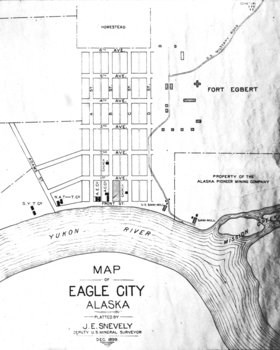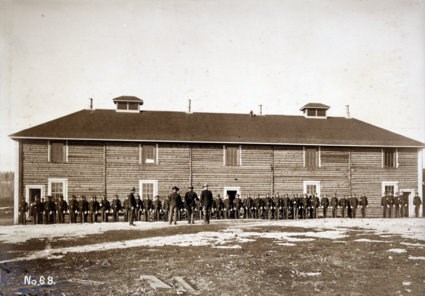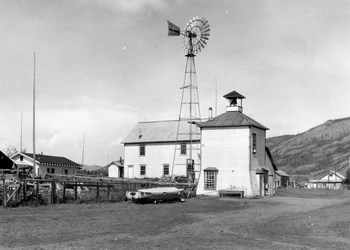
Alaska State Library, Wickersham State Historic Sites Collection
Eagle is thoroughly an American town, and patriotic to the heart in every respect. No impression of regret did we hear from anyone leaving the Canadian country, but were only too glad to get under the flag of the brave old stars and stripes.
—M.D.K. Weimer’s True Story of the Alaska Gold Fields, 1903
Eagle City was founded by a group of disillusioned and restless Klondike prospectors who tired of paying Canadian taxes on their gold discoveries in the Yukon and looked westward to the American side of the border. During the winter of 1897-98, twenty-eight of these disgruntled stampeders followed the Yukon River downstream just twelve miles beyond the U.S.-Canada border to survey for a townsite at a bend in the river not far from where Athabascan Han Indians had a camp called David’s Village and where Hudson Bay Company traders had once run an intermittent trading post called Belle Isle. In the process, the newcomers created something of a phenomenon for the region—a well-organized gold rush boomtown.

UAF Archives, Rare Maps Collection In order to attract would-be property owners to the new location, the town fathers (described by one observer as a “handful of schemers”) rushed an agent to Dawson City to throw the newly-platted lots on the market where they were “readily sold at good figures.” The eager buyers selected their lots by drawing slips of paper out of a hat, and Eagle seemed to spring forth overnight with several hundred tents and crude log cabins and a population of approximately one thousand. They called their new town “Eagle City” because of the eagles nesting on the nearby bluff and because the name seemed appropriately patriotic. Prospectors were aware of placer gold on nearby American Creek, and soon several mining operations were springing up and feeding interest in the new town. In that first year Eagle City attracted three major mercantile companies and a sawmill operator, and the community emerged as the commercial center for mining operations in the upper Yukon region. It was also an important stop for paddlewheel steamboats plying the Yukon River between the Klondike and the Bering Sea.

Alaska State Library, Ft. Egbert Construction Collection The new town also attracted the attention of the Secretary of War who hoped to establish law and order in the gold fields, build roads and communication lines, and assist indigent miners who periodically faced food shortages. The U.S. Army began building Fort Egbert on a patch of undeveloped acreage between Eagle City and Mission Creek in the summer of 1899. The soldiers eventually constructed forty-five buildings on the fort reserve, including officers’ quarters, a granary, a quartermaster’s storehouse, and a large barn for the fort’s horses and mules. Although presence of the military was an economic boon, the gold rush was still unfolding and many residents left in late 1899 to join the stampede to the Nome gold fields.

USGS, John B. Mertie Collection In the decades since Eagle’s heyday as a gold rush hub, the town has become home to a small group of people who enjoy life away from the metropolis. Visitors to Eagle can learn more from the community’s museum exhibits and historic buildings (including the remaining Ft. Egbert buildings) which are listed on the National Register of Historic Places. Visitors can also learn local and regional history from the field headquarters of Yukon-Charley Rivers National Preserve located on the former military reserve grounds.

NPS/Christopher Houlette |
Last updated: April 14, 2015
